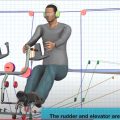723 V1 The forces of flight - Mr David Jackson.
Engineering Studies – H3 Aeronautical Engineering – Mechanical Analysis
This topic uses examples in aeronautical situations to analyse force systems. The key concept is the relationship between lift, weight, thrust, and drag on an aircraft.
Key Concepts
- The forces of flight including:
- Lift
- Weight
- Thrust
- Drag
- Lift to weight ratio
- The ‘angle of attack’.
Discussion Questions
- How is a lift force generally developed on an airplane?
- Discuss why lift force is opposing weight force.
- Discuss why the thrust force opposes the drag force.
- Describe why would the lift to weight ratio be important in aeronautics?
- Explain why would aircraft engineers design to minimise drag and increase thrust?
- Define the term ‘the angle of attack’ in aircraft flight.
- Define the term ‘gliding’.
Downloads
Videos
723 V1 The forces of flight - Mr David Jackson.
723 V2 Flight sample calculations - Mr David Jackson
723 V3 Gliding forces - calculation example - Mr David Jackson
Detailed flying information.
Lift and Wings - Concepts explained.
Links

https://www.bbc.co.uk/bitesize/topics/zvb76v4/articles/zbmkhbk
The Wonder of Wings - BBC Readings

https://youtu.be/AiTk5r-4coc
Animation showing simple machine control of aircraft flight surfaces - YouTube Steve Karp

https://www.teachengineering.org/activities/view/uconn_gliders_activity1
Follow the steps of the engineering design process to design a glider based on certain limitations.
Construct and test a glider model.
Use fluid dynamics concepts to evaluate and discuss glider performance.

What makes aircraft fly?
Understand the concept of forces.
Identify what forces would make an airplane fly higher or land, and what would make an airplane speed up or slow down while moving through the air
Recognize that engineers of all disciplines use their knowledge of forces to design machines, structures and appliances
Educational St




